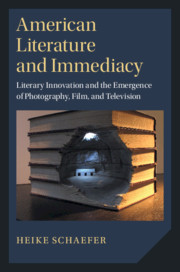 American Literature and Immediacy
American Literature and Immediacy Book contents
- American Literature and Immediacy
- Cambridge Studies in American Literature and Culture
- American Literature and Immediacy
- Copyright page
- Dedication
- Contents
- Acknowledgements
- The Quest for Immediacy in American Literature and Media Culture
- Part I Literary Immediacy and Photography
- Part II Literary Immediacy and the Cinema
- Chapter 4 “Living Moving Pictures”: The Thrills of Early Cinema
- Chapter 5 “Making a Cinema of It”: Seriality and Presence in Gertrude Stein’s Early Literary Portraits
- Chapter 6 “A Novel Like a Documentary Film”: Cinematic Writing as Cultural Critique in John Dos Passos’s Manhattan Transfer
- Part III Literary Immediacy and Television
- Notes
- Bibliography
- Index
- Series page
Chapter 4 - “Living Moving Pictures”: The Thrills of Early Cinema
from Part II - Literary Immediacy and the Cinema
Published online by Cambridge University Press: 19 December 2019
- American Literature and Immediacy
- Cambridge Studies in American Literature and Culture
- American Literature and Immediacy
- Copyright page
- Dedication
- Contents
- Acknowledgements
- The Quest for Immediacy in American Literature and Media Culture
- Part I Literary Immediacy and Photography
- Part II Literary Immediacy and the Cinema
- Chapter 4 “Living Moving Pictures”: The Thrills of Early Cinema
- Chapter 5 “Making a Cinema of It”: Seriality and Presence in Gertrude Stein’s Early Literary Portraits
- Chapter 6 “A Novel Like a Documentary Film”: Cinematic Writing as Cultural Critique in John Dos Passos’s Manhattan Transfer
- Part III Literary Immediacy and Television
- Notes
- Bibliography
- Index
- Series page
Summary
The chapter’s first part describes the interrelated but also contrary development of literature and film in the early twentieth century. It places modernist experiments with literary form in relation to the new representational and narrative strategies of early film. The second part explains in depth which new forms of immediacy the movies offered and how important these immediacy effects were for the cultural impact and popularity of early film, especially the “cinema of attractions.” The chapter also discusses the popular perception of film as a particularly modern medium. It argues that the oscillation between self-reflexivity and immediacy was central to the cultural work performed by early cinema because it allowed early film to train viewers in new forms of attention required by the accelerated pace, fragmentation, and informational density of modern life, while also providing compensatory relief and entertainment. Provoking media awareness as well as experiences of immersion, the early cinema reminded its viewers that their perception of the world was mediated, while the thrill of its immediacy effects offered them moments of respite from such self-reflexive considerations.
Keywords
- Type
- Chapter
- Information
- American Literature and ImmediacyLiterary Innovation and the Emergence of Photography, Film, and Television, pp. 95 - 115Publisher: Cambridge University PressPrint publication year: 2020


